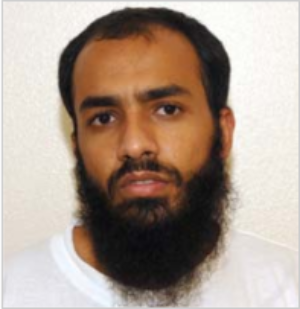The Pentagon announced today that a former Guantanamo detainee known as Yasir al Silmi was killed in an airstrike in Yemen on Mar. 2.

Al Silmi is identified as Muhammad Yasir Ahmed Taher in declassified and leaked files prepared by Joint Task Force Guantanamo (JTF-GTMO). His internment serial number was 679. A picture of Taher taken during his time in Cuba can be seen on the right.
The Obama administration transferred Taher to Yemen on Dec. 19, 2009.
Just days later, on Christmas Day 2009, a would-be suicide bomber attempted to blow up a Detroit-bound airplane. Al Qaeda in the Arabian Peninsula (AQAP), which is based in Yemen, was responsible for the failed attack. The Obama administration subsequently suspended detainee transfers to Yemen.
President Obama’s Guantanamo Review Task Force (GRTF), which evaluated the detainee population throughout 2009, approved Taher for transfer “outside the United States to a country that will implement appropriate security measures.”
The GRTF placed 30 other Yemeni detainees in conditional detention, meaning they could be transferred if certain conditions were met. Some Yemenis were recommended for prosecution. Still others were placed in indefinite detention under the law of war, because they were deemed too dangerous to transfer, but their cases were considered infeasible for prosecution.
As a result, dozens of Yemenis remained incarcerated at Guantanamo for years.
But not Taher. The Defense Department did not say when he rejoined the jihad. But he was reportedly killed in Yemen’s Abyan Governorate alongside Usayd al Adani, a “longtime” AQAP “explosives expert and facilitator.”
Taher himself was detained years earlier on the suspicion that he was part of a cadre that was planning to use explosives against Americans in Afghanistan.
JTF-GTMO: Taher a “high” risk who “will engage in extremist activities upon release”
In a leaked threat assessment dated Mar. 19, 2008, JTF-GTMO deemed Taher a “high” risk to the US, its interests and allies. JTF-GTMO also recommended that Taher remain in detention, reversing a 2007 assessment in which intelligence analysts said he could be transferred.
The JTF-GTMO threat file contains this warning: “It is assessed detainee [Taher] will engage in extremist activities upon release. He has threatened JTF-GTMO personnel and continues to support jihad.”
While in custody, Taher allegedly stated that he wants “the infidels destroyed because they are attacking God.” He supposedly prayed for a linguist to be killed, “threatened to kill members of the JTF-GTMO guard force,” and “threatened to instigate some sort of uprising in the camp, claiming the Americans are assaulting Islam.”
JTF-GTMO found that Taher was an “Islamic extremist” and a member of a Faisalabad, Pakistan “cell created by senior al Qaeda member” Abu Zubaydah. Members of Zubaydah’s cell, known as the “Martyrs Brigade,” fled “hostilities in Afghanistan…with the purpose of returning to Afghanistan to conduct attacks against US and Coalition forces using improvised explosive devices” (IEDs).
JTF-GTMO assessed that Taher fled Afghanistan along with his brother as part of Zubaydah’s “Martyrs Brigade.” Zubaydah originally wanted to set up a base of operations in Iran, but he settled for Faisalabad, which is where the Taher brothers and dozens of others were detained in late Mar. 2002.
The Faisalabad safe houses were part of a logistical support network run by Lashkar-e-Taiba (LeT), an al Qaeda-affiliated Pakistani jihadist group. Taher was found in one of the residences, which was known as the “Issa House.”
Taher also “acknowledged associations with members” of Jamaat Tablighi, a proselytizing group that allegedly facilitated the travel of numerous Guantanamo detainees prior to their detention.
Taher’s brother, known as Ali Abdullah Ahmed, committed suicide at Guantanamo in June 2006. Taher told authorities that his brother “went to Allah.” JTF-GTMO interpreted his reaction to mean that Taher thought his brother “sacrificed himself for jihad against the US and his martyrdom granted him access to paradise.”
JTF-GTMO’s analysts concluded that Taher never truly came clean about his past, despite spending several years in custody in Cuba. Taher and the others captured in Zubaydah’s safe houses allegedly adopted a “false cover story citing education as their purpose for travel to Pakistan.”
Abu Zubaydah: “We and the sheikh (Osama bin Laden) are one.”
In the summer of 2016, US officials released an unclassified summary of Zubaydah’s career, highlighting his close relationships with multiple senior al Qaeda leaders. [See FDD’s Long War Journal report, The Abu Zubaydah file.]

Zubaydah (seen on the right) worked with Khalid Sheikh Mohammed (the chief planner of 9/11), Abu Hafs al Masri (al Qaeda’s “chief of operations” at the time of his death in late 2001), and Abdul Hadi al Iraqi (Osama bin Laden’s chief paramilitary commander in pre-9/11 Afghanistan), among others. Indeed, “the Martyrs Brigade” to which Taher allegedly belonged was jointly established by Zubaydah and Iraqi.
The evidence presented to a Periodic Review Board (PRB) at Guantanamo significantly undermines the claim that Zubaydah was somehow not really an al Qaeda member, as some have argued. Zubaydah apparently has said that he did not swear bayat (an oath of allegiance) to bin Laden. But that claim is difficult, if not impossible, to assess as swearing personal bayat is often of a private matter. Moreover, even if Zubaydah didn’t pledge his undying fealty to bin Laden, he certainly acted as if he had.
In Sept. 2016, the PRB denied Zubaydah’s request to be transferred. The PRB noted that Zubaydah “probably” served as one of bin Laden’s “most trusted facilitators” and has “admitted abilities as a long-term facilitator and fundraiser for extremist causes, regardless of his claim that he was not a formal member of al Qaeda.”
The PRB added an observation that further debunked Zubaydah’s claims of supposed independence. The PRB stated that while Zubaydah’s “responses…minimized his relationship with al Qaeda,” he “contradicted statements he previously made.”
For example, in one video, Zubaydah said the following: “We and the sheikh (Usama Bin Ladin) are one. We have been working together for almost 10 years, but we were hoping to keep this work secret…hidden. We were forced to make ourselves known because of what took place in Afghanistan and thereafter.”
A transcript of this production, aptly titled the “Abu Zubaydah Video,” was submitted as evidence during military commission proceedings. It contains multiple other passages indicating Zubaydah’s loyalty to bin Laden. “To return to your question about our relationship with the sheikh: We and he are one…God granted us success in our endeavors to serve the interest of the Muslims,” one passages reads. And then another: “Sheikh Abu Abdullah [bin Laden] is our Sheikh and our example, may God reward him well on our behalf and on behalf of all Muslims. As they say in the media that we participate with him in some operations, this makes us proud and is an honor for us and we pray to God to grant him and us success…”
Still another part of the transcript reads: “Regarding the question of our relationship to Sheikh Abu Abdullah Yusuf Osama bin Laden…Sheikh Bin Laden, He is our sheikh and our example, our brother, and our Emir for many years, thank God and we cooperate with anyone who serves his religion…”
In other words, Zubaydah didn’t always deny his fealty to bin Laden. He was previously proud of it.
Multiple former Guantanamo detainees joined AQAP
Taher is not the only ex-Guantanamo detainee to rejoin the jihad as a member of AQAP.
In early 2009, two jihadists formerly held at Guantanamo were among the four co-founders of AQAP. Said al Shihri and Mohammed al Awfi spoke during a video announcing the relaunch of al Qaeda’s efforts in the region. Earlier al Qaeda attempts to launch an insurgency in Saudi Arabia were forcefully suppressed. But the four men promised that this time, in Yemen, things would be different. And they were right — AQAP still operates a robust insurgency to this day. However, al Awfi quickly absconded back to Saudi Arabia. Said al Shihri continued to serve as AQAP’s deputy emir until he was struck down by an American drone.
AQAP quickly got to work shortly after their announcement, becoming a major force inside Yemen and directly threatening the US. And jihadists who once were held in Cuba have played significant roles in the group’s operations in the years since.
The al Qaeda branch named Ibrahim Suleiman al Rubaish, who was transferred to Saudi Arabia in Dec. 2006, as its chief ideologue. Rubaish was one of several key AQAP figures killed in drone strikes in 2015.
Fahd Saleh Suleiman al Jutayli was also repatriated to Saudi Arabia in 2006 and killed during a shootout in Yemen three years later, in Sept. 2009. Two other ex-Gitmo detainees who also joined AQAP, Yousef al-Shihri and Othman al Ghamdi, reportedly informed al Jutayli’s family of his death.
Yousef al-Shihri was killed in a separate shootout with Saudi security forces just weeks later. Ghamdi was identified in a 2010 video as an AQAP military commander. According to The Bureau of Investigative Journalism, Ghamdi was likely killed in 2015.
In mid-December 2009, Hani Abdo Shaalan perished in a Yemeni counterterrorism raid in Arhab, which is north of the capital Sanaa. Along with other al Qaeda terrorists, Shaalan was reportedly preparing attacks against the British embassy and other Western targets at the time.
As of late 2015, Ibrahim al Qosi, a longtime aide to Osama bin Laden, was serving as one of the most senior AQAP leaders. Qosi agreed to a plea deal in a military court and was transferred from Guantanamo to his native Sudan in July 2012. But he made his way to Yemen and assumed a prominent position in AQAP. He has been repeatedly featured in the group’s propaganda.
It is likely that still other former Guantanamo detainees have joined AQAP.








4 Comments
I guess Barack Hussein Obama couldn’t know that. Since all these gentlemen killed people outside the US, his conscience is calm. And they weren’t real Muslims anyway. I have yet to read a study on de-radicalisation that doesn’t come to the conclusion that the concept is hogwash.
The free world is very lucky to have survived 8 years of 0bama.
I hope DJT empties Guantanomo and uses it only for short-term interrogations. Release from G should only be to feed the fishes.
I love stories with happy endings.
Does the LWJ know the number of former Guantanamo detainees who have been killed since their release?
Outstanding news. Unfortunately due to Obama’s infantile release program the US taxpayer had to pay for a Hellfire missile when a simple and inexpensive bullet to the back of the head or a lethal injection would have suffice. Better still fly him to his home country and return him to his soil by throwing him out at 30,000 feet.